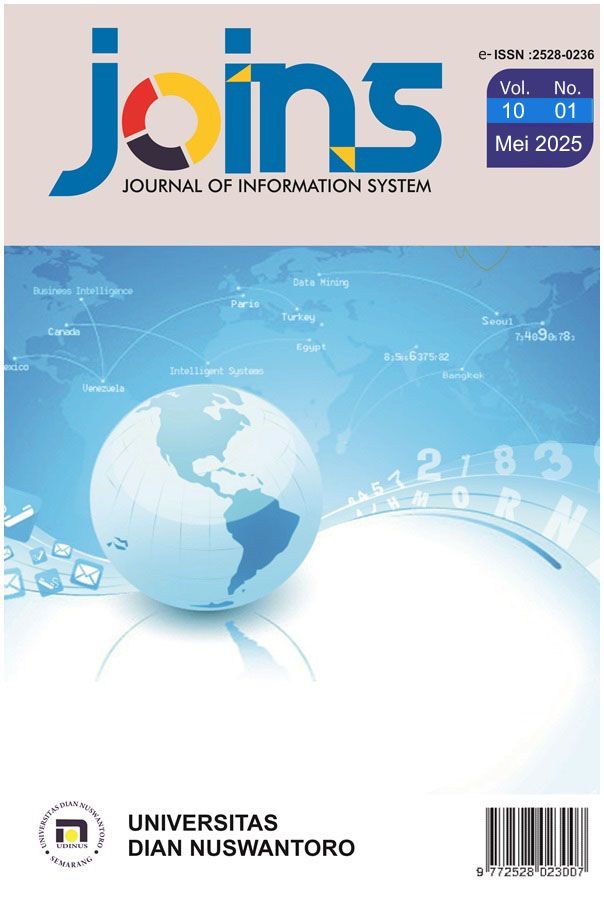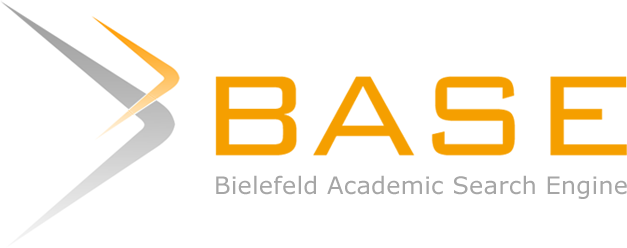Penerapan Metode Hybrid Waterfall-RAD pada Sistem Antrian Web untuk Optimalisasi Layanan di Pengadilan Negeri Bale Bandung
DOI:
https://doi.org/10.33633/joins.v10i1.12668Keywords:
sistem antrian, web-based, hybrid Waterfall-RAD, Pengadilan Negeri Bale BandungAbstract
Penelitian ini bertujuan mengoptimalkan pelayanan publik melalui pengembangan sistem antrian real-time berbasis web di Pengadilan Negeri Bale Bandung, yang sebelumnya menghadapi masalah antrian tidak terorganisir dan waktu tunggu lama akibat sistem manual. Metode pengembangan menggabungkan model Waterfall untuk struktur tahap linier dan pendekatan Rapid Application Development (RAD) untuk iterasi cepat berbasis partisipasi pengguna. Analisis kebutuhan dilakukan secara deskriptif untuk memetakan proses antrian eksisting, dilanjutkan dengan desain sistem berbasis framework CodeIgniter 3 dan MySQL. Implementasi mencakup antarmuka responsif, manajemen antrian otomatis, notifikasi suara, dan pembaruan status real-time. Hasil penelitian menunjukkan bahwa sistem mampu menyederhanakan proses antrian, meningkatkan transparansi melalui pemantauan antrian secara langsung, serta mengurangi waktu tunggu secara signifikan. Keberhasilan ini didukung oleh integrasi metode hibrida Waterfall-RAD yang memadukan kekuatan dokumentasi formal dan pengembangan adaptif. Temuan ini menegaskan pentingnya transformasi digital dalam layanan publik untuk meningkatkan akuntabilitas institusi peradilan, serta memberikan kerangka kerja yang dapat diadopsi oleh instansi pemerintah lain dengan konteks serupa.References
A. P. U. Siahaan dan A. Syahputra, “Pengenalan Sistem Antrian Berbasis Web Di Kantor Dinas Kependudukan Dan Pencatatan Sipil Kota Medan,” Juribmas, vol. 2, no. 3, hlm. 251–263, 2024, doi: 10.62712/juribmas.v2i3.154.
E. Yanti dan S. Suroto, “Penerapan Sistem Antrian Dan Booking Produk Pengadilan Secara Online Di Pengadilan Agama Jambi,” Jurnal Pustaka Mitra (Pusat Akses Kajian Mengabdi Terhadap Masyarakat), vol. 4, no. 4, hlm. 129–135, 2024, doi: 10.55382/jurnalpustakamitra.v4i4.739.
D. Maharani, A. Rahmawati, V. F. D. Putri, dan M. R. Fauzy, “Implementasi Pelayanan Publik Berbasis Digital,” Karimahtauhid, vol. 3, no. 11, hlm. 12143–12155, 2024, doi: 10.30997/karimahtauhid.v3i11.15337.
K. Karmanis, “Urgensi Reformasi Administrasi Dalam Citizen-Centric, Dan E-Government Di Indonesia,” Public Service and Governance Journal, vol. 3, no. 1, hlm. 13–22, 2022, doi: 10.56444/psgj.v3i1.629.
E. B. Purnama, N. Azizah, M. Nuraminudin, dan M. M. Dewi, “Analysis and Design of Queue Service Information System Integrated with WhatsApp using UML Method,” IJCIS, vol. 5, no. 1, hlm. 1–7, Jan 2024, doi: 10.29040/ijcis.v5i1.151.
A. Widarwati, K. Sjamsuri, dan F. M. Amin, “Pengembangan Sistem Antrian Berbasis Web Pada Kemenag Kabupaten Pasuruan Menggunakan Metode Waterfall,” Jati (Jurnal Mahasiswa Teknik Informatika), vol. 8, no. 6, hlm. 12199–12204, 2024, doi: 10.36040/jati.v8i6.11842.
I. Solikin, “Aplikasi Antrian Validasi Wajib Pajak Restoran Kantor Badan Pendapatan Daerah,” Intech, vol. 5, no. 2, hlm. 65–70, 2024, doi: 10.54895/intech.v5i2.2731.
B. A. Sutowo dan A. F. Wijaya, “Analisis Kepuasan Pengguna Terhadap Sistem Pelayanan Publik Kecamatan Beringin Kabupaten Semarang Menggunakan End User Computer Satisfaction,” Journal of Computer and Information Systems Ampera, vol. 4, no. 1, hlm. 1–11, 2023, doi: 10.51519/journalcisa.v4i1.370.
D. Y. Descania, “Penerapan Metode Prototype Pada Pengembangan Sistem Antrian Online Di Kementrian Atr/BPN Kab. Sukabumi,” Indexia Infomatic and Computational Intelligent Journal, vol. 5, no. 01, hlm. 1, 2023, doi: 10.30587/indexia.v5i01.5165.
D. Febrianti dan B. Y. Geni, “Perancangan Sistem Antrian Menggunakan Metode Rad Berbasis Web,” Jati (Jurnal Mahasiswa Teknik Informatika), vol. 8, no. 1, hlm. 1021–1028, 2024, doi: 10.36040/jati.v8i1.8834.
I. Sommerville, Software engineering, 9th ed. Boston: Pearson, 2011.
R. Elmasri dan S. Navathe, Fundamentals of database systems, Seventh edition. Hoboken, NJ: Pearson, 2016.
Arman, Mas’ud, dan Syamsuddin, “Digital Transformation in Public Services: Lessons from The Investment and Integrated One-Stop Services Office of Bima Regency,” Jurnal Pengembangan Masyarakat Islam, vol. 15, no. 1, hlm. 35–50, Jun 2024, doi: 10.20414/komunitas.v15i1.9990.
N. Şat, “Public Services Digital Transformation With Competency Strategies and Future Perspectives:,” dalam Advances in Public Policy and Administration, E. B. Sevinç Çubuk, Ed., IGI Global, 2025, hlm. 1–32. doi: 10.4018/979-8-3693-6547-2.ch001.
E. Ruijer, G. Porumbescu, R. Porter, dan S. Piotrowski, “Social equity in the data era: A systematic literature review of data‐driven public service research,” Public Administration Review, vol. 83, no. 2, hlm. 316–332, Mar 2023, doi: 10.1111/puar.13585.
S. Murdha Anggara, A. Hariyanto, Suhardi, A. Akhmad Arman, dan N. Budi Kurniawan, “The Development of Digital Service Transformation Framework for the Public Sector,” IEEE Access, vol. 12, hlm. 146160–146189, 2024, doi: 10.1109/ACCESS.2024.3406571.
Ho Chi Minh City Cadre Academy. dan B. N. Hien, “Digital Empowerment in Vietnam: How Public Sector Innovation Boosts Citizen Satisfaction,” Arch. Sci., vol. 74, no. 2, hlm. 124–132, Mei 2024, doi: 10.62227/as/74218.
M. Fadhli, D. Nurmalasari, dan M. Akbar, “Penggunaan Metode FIFO Pada Real-Time Monitoring Antrian Pendaftaran Pasien Puskesmas Berbasis Web,” Jurnal Komputer Terapan, vol. 9, no. 1, hlm. 39–49, 2023, doi: 10.35143/jkt.v9i1.5915.
I. T. Pratiwi, Z. Zulfikar, dan Moh. A. A. Widya, “Sistem Informasi Manajemen Paket Ekspedisi CV. MK Express,” Sitech Jurnal Sistem Informasi Dan Teknologi, vol. 4, no. 1, hlm. 7–18, 2021, doi: 10.24176/sitech.v4i1.5834.
R. Akida dan J. M. Kandiri, “E-Government and Service Delivery at Kenya Revenue Authority Headquarters in Nairobi City County, Kenya,” journal-of-public-policy-governa, vol. 8, no. 1, hlm. 1–15, Feb 2024, doi: 10.53819/81018102t5309.
Downloads
Published
How to Cite
Issue
Section
License
Authors who publish with this journal agree to the following terms:
- Authors retain copyright and grant the journal right of first publication with the work simultaneously licensed under a Creative Commons Attribution License that allows others to share the work with an acknowledgement of the work's authorship and initial publication in this journal.
- Authors are able to enter into separate, additional contractual arrangements for the non-exclusive distribution of the journal's published version of the work (e.g., post it to an institutional repository or publish it in a book), with an acknowledgement of its initial publication in this journal.
- Authors are permitted and encouraged to post their work online (e.g., in institutional repositories or on their website) prior to and during the submission process, as it can lead to productive exchanges, as well as earlier and greater citation of published work (See The Effect of Open Access).

This work is licensed under a Creative Commons Attribution 4.0 International License.






















